
This year marks the 30th anniversary of the Karabakh Movement, a monumental event in the collective and historical memory of the Armenian nation. Mass demonstrations starting in early 1988 called for the reunification of the Nagorno Karabakh Autonomous Oblast (NKAO) – an autonomous enclave within Azerbaijan SSR – with Soviet Armenia. The popular movement made headlines around the world and led to the reawakening and transformation of the Armenian nation.
The historic Armenian lands of Nagorno Karabakh were forcibly placed under Azerbaijani rule in 1921 by Joseph Stalin. For the next seven decades, Azerbaijan’s policy of discrimination against Nagorno Karabakh was aimed at artificial suppression of its socioeconomic development and active de-Armenianization. Armenian monuments and cultural heritage were destroyed or presented as having Azerbaijani origin. Because of this ethnic discrimination, the majority Armenian population of Karabakh never abandoned its intent and desire to separate from Azerbaijan SSR.
Indeed, during the Soviet era, a number of attempts by Armenians were made to raise the Nagorno Karabakh issue before the central authorities of the USSR primarily after the Second World War. Representatives of the people of Nagorno Karabakh appealed to Moscow with numerous letters and petitions (1945, 1965, 1967, 1977).
First Secretary Mikhail Gorbachev’s policy of glasnost and perestroika toward the end of the 1980s that were meant to liberalize the Soviet Union’s political and economic landscape, provided a historic opportunity for the Armenians of Karabakh to once again express their grievances and demand reunification with the homeland.
It was a time of sweeping global changes that would lead to the fall of the Berlin Wall in 1989 and the eventual collapse of the Soviet Union in 1991.
Starting in 1987, demonstrations were taking place in Soviet Armenia over environmental concerns that included demands for the shut down of the Medzamor Nuclear Power Plant. These environmental concerns would ultimately transform into a wider pan-national movement not only for the people’s right to self-expression, but would pave the path to independence.
When the movement began, it did not bear any anti-Soviet bias and there were no calls for immediate independence for Armenia. However, by the spring of 1988, when it became clear that all possible solutions to the problem of Karabakh were unattainable within the framework of the Soviet system, this all changed. A symbolic moment was on May 28, 1988, the 70th anniversary of the First Armenian Republic (1918-1920) when Movses Gorgisyan hoisted the Armenian tricolor flag in Yerevan’s Opera Square.
A group of young intellectuals, who came to be known as the Karabakh Committee led the movement later transforming into the Pan-Armenian National Movement. The events of 1988 unravelled quickly and by 1991 both Armenia and Nagorno Karabakh had declared independence. Soon after, a full-scale war with Azerbaijan exploded lasting almost four years with the Armenians gaining control of Nagorno Karabakh, officially known today by its Armenian name, Artsakh.
The Karabakh Movement was one of the largest protest movements in Soviet history.
Below is a brief timeline of the major events of 1987-1988.
1987
March 3
August 5
August 13-14
October 17
October 18
A demonstration in Yerevan demands that Karabakh and Nakhichevan be reunited with Soviet Armenia. The police intervene to disperse the rally.

An environmental rally in Yerevan, 1987.
1988
February 13
February 20
February 21
February 22

Demonstrations in Stepanakert.
February 23
The Central Committee of the Communist Party of the USSR responds negatively to the demand by the government of Nagorno Karabakh for unification with Armenia: “Breaching of public order was provoked as a result of irresponsible calls by extremist individuals…Having examined the information about developments in the Nagorno Karabakh Autonomous Oblast, the CPSU Central Committee holds that the actions and demands directed at revising the existing national and territorial structure contradict the interests of the working people in Soviet Azerbaijan and Armenia and damage inter-ethnic relations.”
The only concession made by Soviet authorities was the naming of Henrikh Poghosyan as the new Communist Party leader in NKAO replacing Boris Kevorkov, who was cited as insensitive to Armenian needs.
February 25
His Holiness Vazgen I, Supreme Patriarch and Catholicos of All Armenians sends a letter to General Secretary Gorbachev:
“During the last few days we have been receiving numerous letters, telegrams, telephone calls from Armenia, and in particular from our bishops and church and cultural organizations overseas which, in the name of the over two million Armenians of the Diaspora, are requesting that we intervene with the high authorities in the Soviet Union, so that the question of Armenian Karabakh receives a just solution, based on our constitution and according to a resolution of the Soviet of People’s Deputies in Karabakh and to democratic principles.
We are deeply concerned with the serious situation created, particularly given the fact that we have received news that there have been human victims and Armenian historical church monuments have been damaged.”
From February 25-28, communities across the Armenian Diaspora organize solidarity protests in Paris, New York, Washington, Montreal, Toronto, Cambridge and Los Angeles. Similar gatherings are also organized in Argentina, Lebanon, Greece and elsewhere.
February 26
Mikhail Gorbachev makes an unprecedented public appeal for calm and sends three members of the Politburo to Armenia, along with a Communist Party secretary in an effort to stop the demonstrations. His message in Armenia was read in Russian over Yerevan Radio by Politburo member Vladimir I. Dolgikh:
“I must say frankly that the Soviet Communist Party Central Committee has been disturbed by this turn of events. It is fraught with serious consequences. We do not wish to evade a frank, sincere discussion of various ideas and proposals. But this must be done calmly, within the framework of democratic process and legality, without allowing even the slightest damage to the internationalist cohesion of our peoples. The most serious questions of the people’s destiny cannot be placed in the power of spontaneity and emotion.”
However, according to some reports, in an unprecedented show of defiance to Soviet authorities, as many as one million people take to the streets in Yerevan.
The Associated Press quoted sources in Yerevan saying that troops had been alerted and tanks moved to the outskirts of the city.
While mass rallies continue in Yerevan, the 11-member “Organizing Committee of the Karabakh Movement in Armenia” known as the Karabakh Committee is established under the leadership of Igor Muradyan. The committee was comprised mostly of intellectuals but by May 1988, the two original leaders – Igor Muradyan and Zori Balayan – had been edged aside. In an interview to Thomas de Waal, Levon Ter Petrosyan, one of the later members of the Karabakh Committee who would go on to be independent Armenia’s first President said:
“The first Karabakh Committee – Igor Muradyan, Zori Balayan, Sylva Kaputikyan and others – thought only about Karabakh. For them, issues like democracy or the independence of Armenia simply did not exist. And this was the ground where the split occurred. When they felt that we were already becoming dangerous for the Soviet system, they left. A natural change took place. They thought that the Karabakh question had to be solved by using the Soviet system. And we understood that this system would never solve the Karabakh issue and that the reverse was true; you had to change the system to resolve this problem.”
February 27
His Holiness Catholicos Karekin II of the Great House of Cilicia sends a telegram to Secretary General Mikhail Gorbachev:
“Your Excellency is aware that geographically, historically and ethnographically Karabakh is part of Armenia. It was a historical error to annex it to the Azerbaijani Republic. The Armenians of Karabakh, of Soviet Armenia, and all over the Diaspora have never ceased to demand that Karabakh be attached to the motherland, to Armenia…We sincerely believe and warmly request from Your Excellency to correct the error committed in 1923 and to make justice work for the Armenian people, by reattaching Karabakh to the Soviet Armenian Republic.”
Also on this day, the leaders of the mass movement in Armenia call for a one month suspension of all demonstrations as Gorbachev promises to personally review the Karabakh situation and appeal for calm.
February 27-29
Sumgait Pogroms
Beginning on February 27, a pogrom lasting three days against the Armenian population takes place in the industrial city of Sumgait in Soviet Azerbaijan. At the time, approximately 18,000 Armenians are living in Sumgait which had a population of 200,000.
Mobs of ethnic Azerbaijanis target, attack and kill Armenians in their homes and on the streets of the city. One day later, on February 28, a small contingent of troops from the Ministry of Internal Affairs attempts to put an end to the widespread rioting without success. It is only after the government imposes a state of martial law that the massacre is put to an end.
Official figures released at the time by the Prosecutor General of the USSR put the number of dead at 32, although unofficial reports place the figures much higher.
The scale and scope of the atrocities in Sumgait Pogrom – there are documented cases of Armenians dragged from their homes and burned in the streets – is linked to the Armenian Genocide in the consciousness of the people.
By the evening of February 29, martial law is imposed and troops patrol the streets of Sumgait. Armenian residents, under heavily armed guards, are transported to a cultural facility that was designed to accommodate only several hundred people however, several thousand Armenians eventually are sheltered there until they can leave.
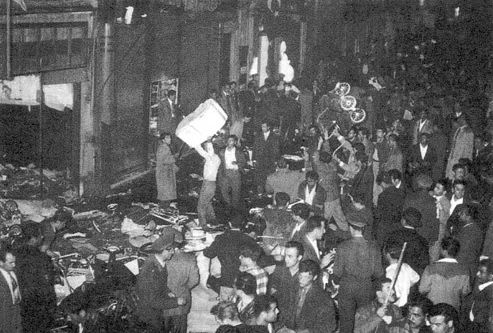
Sumgait, February 27-29, 1988.
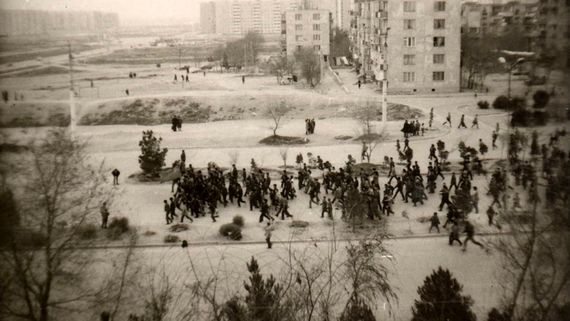
Sumgait, February 27-29,1988.
March 8
March 17
March 22
Army units move to Yerevan to blockade Opera Square to prevent the planned rally for March 26.
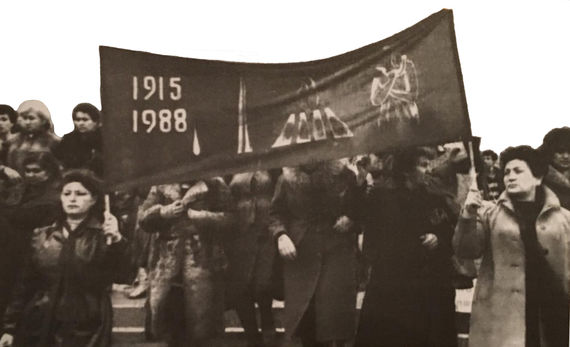
March 25
March 26
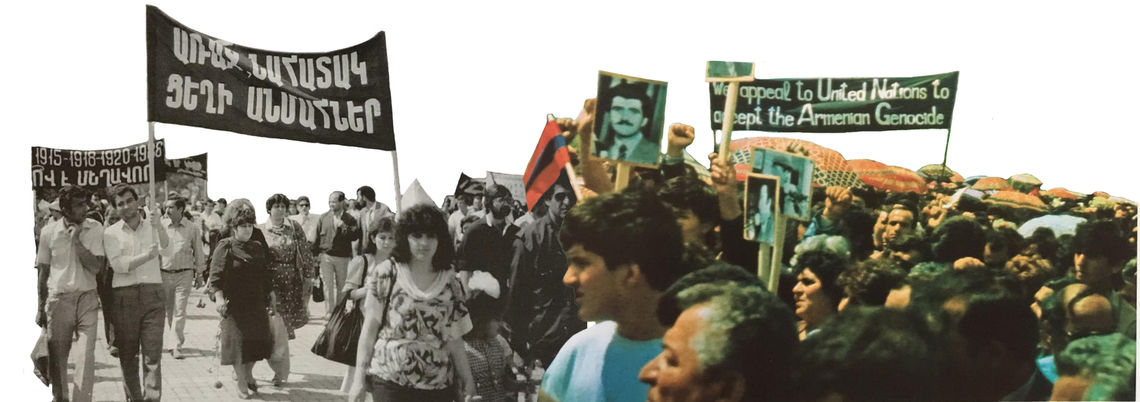
April 24
May 1
May 12-16
May 19
Igor Muradyan organizes a rally in Opera Square in support of the First Secretary of the Central Committee of the Communist Party of Armenia, Karen Demirchyan where he calls for the use of force against force. A few days later, a new membership of the Karabakh Committee is established without Muradyan.

May 21
May 28
June 1
The Nagorno Karabakh District Television station is established.
June 4-15
Peaceful demonstrations continue and intensify in Yerevan and Stepanakert. Hunger strikes and sit-ins at Opera Square are organized by hundreds of students who demand a session of the Supreme Soviet of Armenian SSR to give a positive response to the resolution of the Regional Soviet of NKAO on reunification with Armenia. They also appeal to authorities to remove the Sumgait trials from Azerbaijani courts to the All-Union Supreme Court to ensure impartiality.
On June 12, the legislature of Nagorno Karabakh unanimously votes to secede from Azerbaijan and to rejoin Soviet Armenia. The legislature also votes to rename the region Artsakh, it’s pre-fourteenth century Armenian name. The same day, the presidium of the Supreme Soviet of Azerbaijan rejects the Nagorno Karabakh vote declaring it “null and void.”
June 14
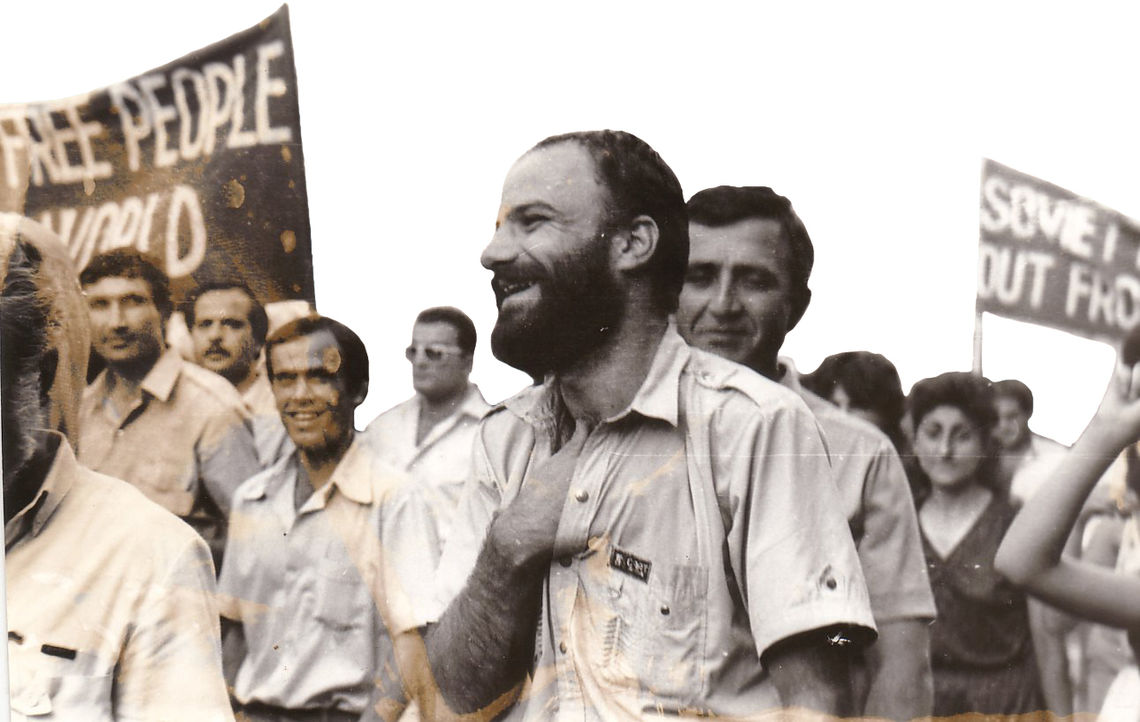
Gorgisyan during a rally in Yerevan, 1988.

Students of Yerevan State Conservatory during a sit-in, 1988.
source
June 15
June 16
July 4
July 5
July 12
The session of the Regional Soviet of NKAO announces its separation from Azerbaijan SSR.
July 18
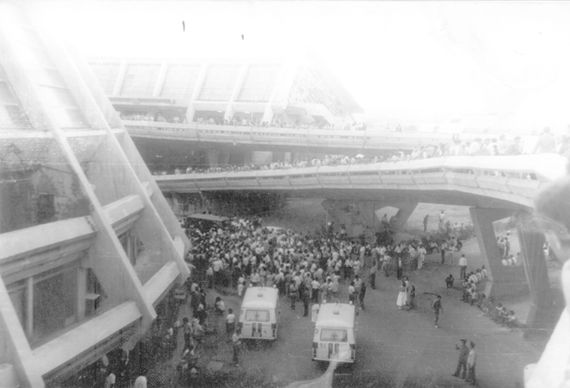
An emergency session of the USSR Supreme Soviet Presidium rejects the demands by the Armenians for reunification citing Article 78 of the Soviet Constitution, however, promises to enhance self-government, better living conditions, the formation of a task force to supervise the region’s return to order and the formation of a government commission to study additional measures to address and ease Armenian complaints. It is decided to send a delegation of representatives of the Presidium of the Supreme Soviet of the USSR headed by Arkadi Volski to NKAO.
On the same day, Henrik Poghosyan, the First Secretary of the Nagorno Karabakh District Committee of the Communist Party emphasizes the impossibility of NKAO remaining within Azerbaijan SSR.
July 27
July-August
August 19
September 18
September 19
At a massive rally in Yerevan, Hrant Voskanyan, the Chairman of the Armenian SSR Presidium announces immediate plans for parliament to meet to examine the issue of Karabakh again. Demonstrators decide to continue a general strike until parliament convenes.
September 21
September 20
Moscow declares a state of emergency in Nagorno Karabakh. A curfew comes into force and foreign journalists are banned from Azerbaijan and Armenia. Despite the ban, protests and general strikes continue in Yerevan. Major cities across the country are paralyzed.
October 9
October 18
November 18
November 19
A massive demonstration takes place in Baku, the capital of Azerbaijan SSR protesting the death sentence. By November 22, violence that had started in Baku spreads to other towns and villages in Azerbaijan, Nagorno Karabakh and the exclave of Nakhichevan. A curfew is implemented and tanks and troops are deployed to Baku, Kirovabad and Nakhichevan. Approximately 500 Armenian women and children are evacuated from Nakhichevan by troops and sent to Armenia.
November 22
Four soldiers are killed in Kirovabad during anti-Armenian riots. On the same day, the session of the Supreme Soviet of Armenian SSR passes a law condemning the 1915 Genocide of Armenians by Ottoman Turkey. The session is cut short, however, as news is received about the acts of violence against Armenians in Baku, Kirovabad, Nakhichevan and other Armenian-populated regions of Azerbaijan. Deportation of Armenians from Azerbaijan commences.
November 24
December 7
Earthquake
December 10
December 11
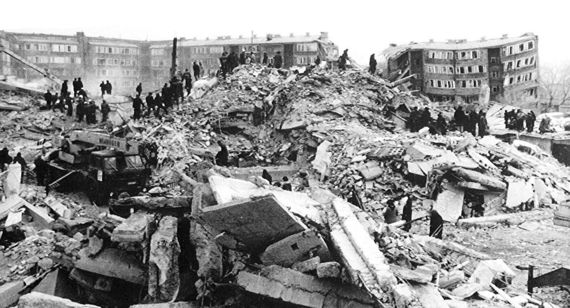
Gyumri, December 1988.
Mass demonstrations take place in Yerevan protesting the arrest of the members of the Karabakh Committee, clashes ensue.
On December 10 and 11, rumors quickly spread that authorities are taking the orphans from the earthquake (more than 10,000) out of Armenia to be adopted by other nationalities within the Soviet Union. The rumors are caused by reports in the Soviet press urging non-Armenian citizens to adopt the Armenian orphans. Several hundred injured children were flown to other parts of the Union to receive medical treatment; it was suspected that the flights were part of the adoption scheme. Armenians are outraged and about 100,000 people gather at Opera Square to oppose this. A melee ensues, protesters clash with police and this is used as a pretext to arrest the seven members of the Karabakh Committee. They are charged with “fomenting public disorder.”
In February 1989, Tass [news agency] placed the number of victims during the previous year’s conflict in Azerbaijan and Armenia at 91 dead and 1,650 injured. Among the casualties were four Soviet soldiers, as well as 117 troops and 32 militiamen injured. Criminal charges were filed against 517 people without specifying their nationality. In addition nearly 300,000 had fled their homes in both republics. More than 100 “chiefs of internal affairs organs” had been fired or reprimanded in Azerbaijan.

